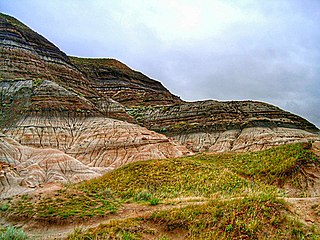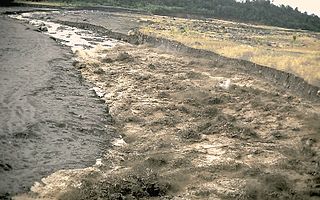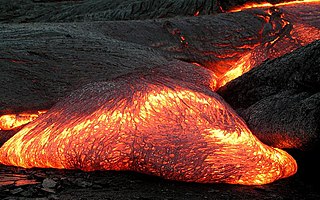 W
WVolcanism is the phenomenon of eruption of molten rock (magma) onto the surface of the Earth or a solid-surface planet or moon, where lava, pyroclastics and volcanic gases erupt through a break in the surface called a vent. It includes all phenomena resulting from and causing magma within the crust or mantle of the body, to rise through the crust and form volcanic rocks on the surface.
 W
WThe Cretaceous–Paleogene (K–Pg) boundary, formerly known as the Cretaceous–Tertiary (K-T) boundary, is a geological signature, usually a thin band of rock. The K–Pg boundary marks the end of the Cretaceous Period, the last period of the Mesozoic Era, and marks the beginning of the Paleogene Period, the first period of the Cenozoic Era. Its age is usually estimated at around 66 Ma, with radiometric dating yielding a more precise age of 66.043 ± 0.011 Ma.
 W
WThe Alpide belt or Alpine-Himalayan orogenic belt is a seismic belt and orogenic belt that includes an array of mountain ranges extending for more than 15,000 km along the southern margin of Eurasia, stretching from Java and Sumatra, through the Indochinese Peninsula, the Himalayas and Transhimalayas, the mountains of Iran, Caucasus, Anatolia, the Mediterranean, and out into the Atlantic. It includes, from west to east, the major ranges of the Atlas Mountains, the Alps, the Caucasus Mountains, Alborz, Hindu Kush, Karakoram, and the majestic Himalayas. It is the second most seismically active region in the world, after the circum-Pacific belt, with 17% of the world's largest earthquakes.
 W
WA batholith is a large mass of intrusive igneous rock, larger than 100 square kilometres (40 sq mi) in area, that forms from cooled magma deep in the Earth's crust. Batholiths are almost always made mostly of felsic or intermediate rock types, such as granite, quartz monzonite, or diorite.
 W
WBimodal volcanism is the eruption of both mafic and felsic lavas from a single volcanic centre with little or no lavas of intermediate composition. This type of volcanism is normally associated with areas of extensional tectonics, particularly rifts.
 W
WA block and ash flow or block-and-ash flow is a flowing mixture of volcanic ash and large angular blocks commonly formed as a result of a gravitational collapse of a lava dome or lava flow. Block and ash flows are a type of pyroclastic flow and as such they form during volcanic eruptions. In contrast to other types of pyroclastic flows, block and ash flows do not contain pumice and the volume of block and ash flow deposits is usually small. Block and ash flow deposits have densities in the range of 1600 to 2000 kg/m3, two to five times greater than ash fall deposits. Some blocks in block and ash flow deposits may have thin and shiny coatings of carbon derived from charcoal formed from vegetation trapped by the flow.
 W
WThe Bridge River Ash is a large geologically recent volcanic ash deposit that spans from southwestern British Columbia to central Alberta, Canada. The ash consists of dust-sized shards ellipsoidal fragments of pumice. It overlaps the Mount St. Helens Yn Ash and the Mazama Ash which were erupted from Mount St. Helens and Mount Mazama about 3,400 and 6,800 years ago.
 W
WIn geodynamics, delamination refers to the loss and sinking (foundering) of the portion of the lowermost lithosphere from the tectonic plate to which it was attached.
 W
WA diatreme, sometimes known as a maar-diatreme volcano, is a volcanic pipe formed by a gaseous explosion. When magma rises up through a crack in the Earth's crust and makes contact with a shallow body of ground water, rapid expansion of heated water vapor and volcanic gases can cause a series of explosions. A relatively shallow crater is left and a rock-filled fracture in the Earth's crust. Diatremes breach the Earth's surface and produce a steep inverted cone shape.
 W
WA dike swarm or dyke swarm is a large geological structure consisting of a major group of parallel, linear, or radially oriented magmatic dikes intruded within continental crust or central volcanoes in rift zones like in Iceland.or other big volcanoes, resp. fissure systems in different parts of the world.
 W
WA flammagenitus cloud, also known as a flammagenitus, pyrocumulus cloud or fire cloud, is a dense cumuliform cloud associated with fire or volcanic eruptions that may produce dry lightning.
 W
WGeothermal energy is the thermal energy generated and stored in the Earth. Thermal energy is the energy that determines the temperature of matter. The geothermal energy of the Earth's crust originates from the original formation of the planet and from radioactive decay of materials. The adjective geothermal originates from the Greek roots γῆ, meaning Earth, and θερμός, meaning hot.
 W
WGlaciovolcanism is volcanism and related phenomena associated with glacial ice. The ice commonly constrains the erupted material and melts to create meltwater. Considerable melting of glacial ice can create massive lahars and glacial outburst floods known as jökulhlaups.
 W
WIce cauldrons are ice formations within glaciers that cover Subglacial volcanoes. They can have circular to oblong forms. Their surface areas reach from some meters to up to 1 or more kilometers.
 W
WThe Komatii Formation is a 3.475 billion year old rock formation, named after the nearby Komati River in South Africa. It is the type locality for komatiite, a high temperature, magnesium-rich volcanic rock.
 W
WA lahar is a violent type of mudflow or debris flow composed of a slurry of pyroclastic material, rocky debris and water. The material flows down from a volcano, typically along a river valley.
 W
WLava is molten rock (magma) that has been expelled from the interior of some planets and some of their moons. Magma is generated by the internal heat of the planet or moon and it is erupted as lava at volcanoes or through fractures in the crust, usually at temperatures from 700 to 1,200 °C. The solid rock resulting from subsequent cooling is also often described as lava.
 W
WA lava channel is a stream of fluid lava contained within zones of static lava or lava levees. The initial channel may not contain levees per se, until the parental flow solidifies over what develops into the channel and creates natural levees. This initial levee allows for the building of a more complex levee and channel. As the lava flows through the channel, the elevation of the surface of the lava flow pulsates and lava can possibly flood the associated channel walls spilling out of the channel and over the existing levees, creating what is known as overflow levees. Overflow levees increase the height and width of the original levee. The lava that flows in lava channels is commonly basaltic in composition.
 W
WThe Maar Museum in Manderscheid in the German state of Rhineland-Palatinate is a museum whose focus is natural variety and international significance for science and the region of the volcanic maars that characterise parts of the Eifel mountains.
 W
WMagma is the molten or semi-molten natural material from which all igneous rocks are formed. Magma is found beneath the surface of the Earth, and evidence of magmatism has also been discovered on other terrestrial planets and some natural satellites. Besides molten rock, magma may also contain suspended crystals and gas bubbles.
 W
WA mudpot, or mud pool, is a sort of acidic hot spring, or fumarole, with limited water. It usually takes the form of a pool of bubbling mud. The acid and microorganisms decompose surrounding rock into clay and mud.
 W
WPele's hair is a form of lava. It is named after Pele, the Hawaiian goddess of volcanoes. It can be defined as volcanic glass fibers or thin strands of volcanic glass. The strands are formed through the stretching of molten basaltic glass from lava, usually from lava fountains, lava cascades, and vigorous lava flows.
 W
WA pit crater is a depression formed by a sinking or collapse of the surface lying above a void or empty chamber, rather than by the eruption of a volcano or lava vent. Pit craters are found on Mercury, Venus, Earth, Mars, and the Moon. Pit craters are often found in a series of aligned or offset chains and in these cases, the features is called a pit crater chain. Pit crater chains are distinguished from catenae or crater chains by their origin. When adjoining walls between pits in a pit crater chain collapse, they become troughs. In these cases, the craters may merge into a linear alignment and are commonly found along extensional structures such as fractures, fissures and graben. Pit craters usually lack an elevated rim as well as the ejecta deposits and lava flows that are associated with impact craters. Pit craters are characterized by vertical walls that are often full of fissures and vents. They usually have nearly circular openings.
 W
WA pyroclastic flow is a fast-moving current of hot gas and volcanic matter that flows along the ground away from a volcano at velocities of 100 km/h (62 mph) on average but is capable of reaching speeds up to 700 km/h (430 mph). The gases and tephra can reach temperatures of about 1,000 °C (1,830 °F).
 W
WThis timeline of volcanism on Earth includes a list of major volcanic eruptions of approximately at least magnitude 6 on the Volcanic Explosivity Index (VEI) or equivalent sulfur dioxide emission during the Quaternary period. Other volcanic eruptions are also listed.
 W
WVog is a form of air pollution that results when sulfur dioxide and other gases and particles emitted by an erupting volcano react with oxygen and moisture in the presence of sunlight. The word is a portmanteau of the words "volcanic" and "smog". The term is in common use in the Hawaiian islands, where the Kīlauea volcano, on the Island of Hawaiʻi (the "Big Island"), erupted continuously between 1983 and 2018. Based on June 2008 measurements, Kīlauea emitted 2,000–4,000 tons of sulfur dioxide (SO2) every day.
 W
WA volcano is a rupture in the crust of a planetary-mass object, such as Earth, that allows hot lava, volcanic ash, and gases to escape from a magma chamber below the surface.